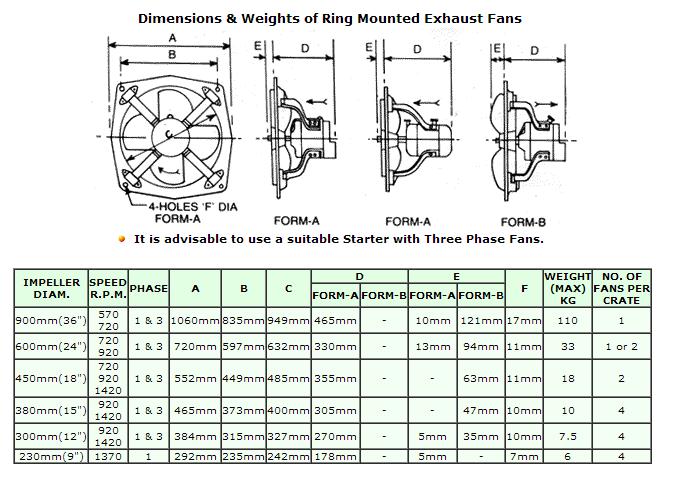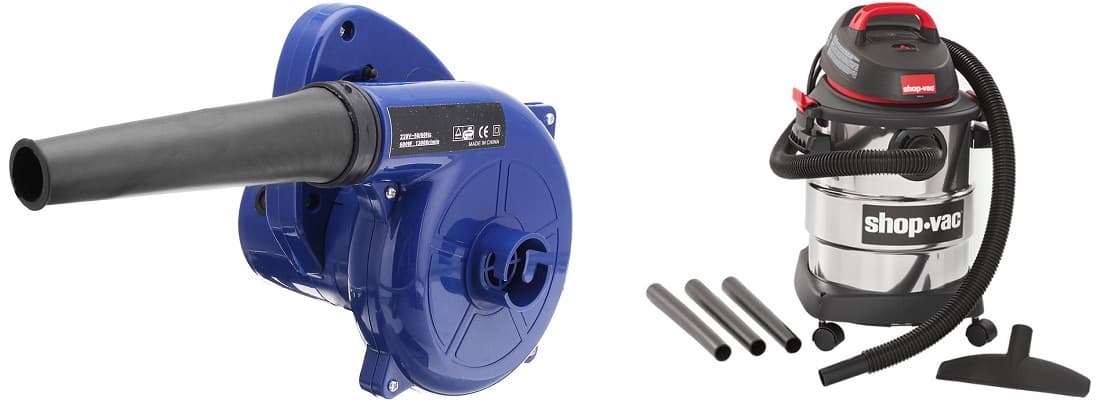In a closed space like a kitchen or bathroom, you would need to have an exhaust fan. The exhaust fan is required to ensure that the air circulation is proper. The exhaust fan also helps you get rid of smell and humidity. One another important factor to take care of is the size of the fan. If the fan is small, it would be useless as it would not remove enough air from the room. In such a case, you need to have an exhaust fan of an adequate size to take care of the needs.
In this section, we have listed a size chart to understand what CFM you would need for a standard size room. Check out the details below.
Formula to be used
- Area of the Room = Length * Width * Height
- Air Changing Rate (ACH) Rate =X Times/Hour
- Size of Fan = Area of Room * ACH Rate / 60
We have shared a reference table below, but we also understand that the size of your room may be different from the one mentioned in the table. So, what you can do is that you can plug in your values in the formula and get the estimated CFM of the exhaust fan. You can get the recommended CFM of the exhaust fan from the formula or table below. Remember that the ACH is an important factor for consideration. The humid areas like the kitchen, bathroom and utility room would need a higher ACH. You can alter the value of ACH depending on your needs. For example, if you spend a lot of time in your garage and live in a humid climate, you should consider a higher ACH value.
| Type of Room | Length (feet) (L) | Width (feet) (W) | Height (feet) (H) | Area (cubic feet) (A) | Recommended ACH (Times/Hour) (ACH) | Size of Ventilation Fan (CFM) (A*ACH/60) |
| Bathroom | 10 | 15 | 10 | 1500 | 15 | 375 |
| Bedroom | 12 | 12 | 10 | 1440 | 4 | 96 |
| Hall | 20 | 12 | 10 | 2400 | 5 | 200 |
| Kitchen | 10 | 10 | 10 | 1000 | 15 | 250 |
| Living Area | 15 | 10 | 10 | 1500 | 5 | 125 |
| Toilet | 6 | 5 | 10 | 300 | 8 | 40 |
| Utility Room | 12 | 10 | 10 | 1200 | 15 | 300 |
| Garage | 15 | 10 | 10 | 1500 | 8 | 200 |
This table should help you choose the size of the exhaust fan, and using this; you can check the available options for you. Avoid buying anything smaller than the recommended value. Also, the higher the CFM, the noisier the exhaust fan can be. You should also check the same and opt for a noiseless exhaust fan wherever possible.
Exhaust Fan Size Chart

How To Choose Right Size Exhaust Fan For Your Bathroom
The NEC & local building codes mandate the use of bathroom vent fans in any bathroom without an openable window for ventilation. Even if window frames are present, they may be required in some jurisdictions.
Both hot and moist air is removed by vent fans, and odors can be eliminated as well. In humid environments, mold thrives and odors are a source of general issue.
But even if the fan fulfills the basic standards, installing a poor, undersized exhaust fan is mostly not worth the effort. Knowing how exhaust fans are sized and selecting one with the appropriate capacity for your space is important.
Standard fan size
In CFM, bathroom exhaust fans are classed for how much air they can move. For bathrooms of less than 100 square feet, standard fan sizing is used. One CFM per sq foot of the room is the general rule of thumb.
Multiply your bathroom’s length and width to figure out how many square feet it is. For instance, if your restroom is 6 feet wide & nine feet long, the area is 54. Because of this, the fan should be rated at least 54 CFM. The following are some things to keep in mind before you begin your search for the perfect wedding dress.
- Oversizing the fan is a good first step. For example, if you have a 54-square-foot room, you should set up a 60 CFM fan.
- Second, you may need two fans if the restroom has a jet tub and separate rooms and alcoves.
- If your bathroom is 42 square feet only, you do need a 50 CFM fan because the lowest allowed fan sizing is 50 CFM.
The size and length of the ductwork must be taken into account when selecting the correct size of a vent fan. A 4-inch round duct will suffice for the majority of 50 CFM fans. However, like the CFM of the fan increases, the duct size has to be raised to 5-6” round ducts. Additionally, the length of the run and the number of fittings, elbows, and so on will influence the quantity of air the duct can carry.
Expert Tip
It is important to take into account how much noise a particular fan will make once you have selected the right size. If you’re trying to create a tranquil and restful atmosphere in your bathroom, consider purchasing a whisper-quiet fan.
Several formulas must be used to determine the proper duct size depending on the length of the run and the fan’s configuration, but these are spelled out in the user manual that comes with the fan. The ductwork should be able to fit in the space where the fan is to be installed. Ventilation will be inadequate if too much air is forced through a duct that is too small.
Sizing for big bathrooms
For bathrooms larger than 100 square feet, the count of fixtures with the in-room determines the appropriate size of the exhaust fan. Add the CFM ratings for each fixture together to get the total number of CFMs needed.
- Toilet: 50 CFM
- Shower: 50 CFM
- Jetted Tub: 100 CFM
- Bathtub: 50 CFM
If your bathroom only has a toilet and a shower, you’ll need a 100 CFM fan. If your bathroom also has a jetted bath, toilet, & shower, you’ll need a 200 CFM fan.
For large, high-ceilinged rooms, a different calculation technique is beneficial (well over 8 feet). The square footage is multiplied by the ceiling height, divided by 60 (minutes in an hour), and multiplied by eight in this manner. For a 120-square-foot room with a 10-foot ceiling, for instance:
- 120 x 10= 1200
- 1200/60=20
- 20 x 8= 160 CFM
A second fan might be required
Installing a distinct exhaust fan for a closed-off toilet and shower area in your bathroom is highly recommended. 50 CFM is ideal for small enclosed spaces. If not, you’ll need to make a calculation based on the size of the room. Just keep in mind that the fan requires airflow to perform its duties.
As a result, the fan’s performance will be impaired if the enclosure’s door is closed and there is no deficit at the door bottom. When using a toilet or shower, you must leave the door ajar if the disparity under the entrance in the compartment is far less than 5/8 inch. Installing an air-flow-enhancing louvered door is yet another option.
Expert Tip
Even blue-tooth speakers have been incorporated into some modern vent fans for added convenience. Vent fans with additional accessories, such as heat lamps, may necessitate a separate power supply, so keep this in mind when sizing the unit. Most local power codes allow the vent fan to be driven by the same lighting circuit as the room’s light fittings if it is only a vent fan.

Santosh Kumar is an editor at unfoldstuffs.com and a professional content writer. With years of experience he is passionate for creating engaging, informative and impactful topics.









